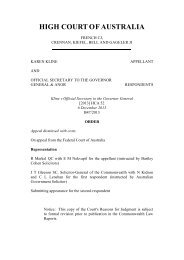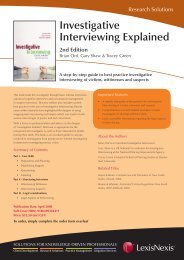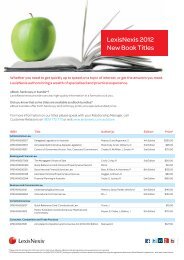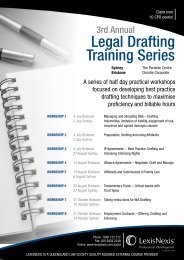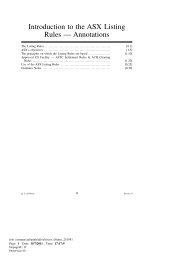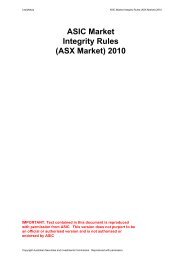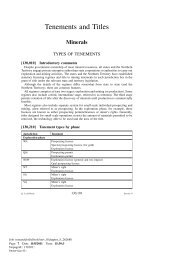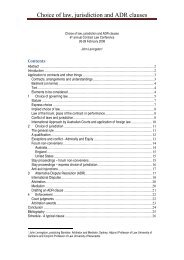Copyright LexisNexis. Sample only, not for classroom use or ...
Copyright LexisNexis. Sample only, not for classroom use or ...
Copyright LexisNexis. Sample only, not for classroom use or ...
Create successful ePaper yourself
Turn your PDF publications into a flip-book with our unique Google optimized e-Paper software.
PRINCIPLES OF AUSTRALIAN EQUITY AND TRUSTS<br />
expectation generated by somewhat oblique remarks was sufficiently clear and certain to establish a<br />
proprietary estoppel claim.<br />
12.35 F<strong>or</strong> the sufficiently clear and unambiguous promise <strong>or</strong> representation to lead to a claim<br />
based upon equitable estoppel, in Waltons St<strong>or</strong>es v Maher at CLR 428–9; ALR 542, Brennan J set out<br />
what he saw as the elements that had to be satisfied, as follows:<br />
In my opinion, to establish an equitable estoppel, it is necessary <strong>f<strong>or</strong></strong> a plaintiff to prove that<br />
(1) the plaintiff assumed that a particular legal relationship then existed between the plaintiff<br />
and the defendant <strong>or</strong> expected that a particular legal relationship would exist between them<br />
and, in the latter case, that the defendant would <strong>not</strong> be free to withdraw from the expected legal<br />
relationship; (2) the defendant has induced the plaintiff to adopt that assumption <strong>or</strong> expectation;<br />
(3) the plaintiff acts <strong>or</strong> abstains from acting in reliance on the assumption <strong>or</strong> expectation; (4) the<br />
defendant knew <strong>or</strong> intended him to do so; (5) the plaintiff’s action <strong>or</strong> inaction will occasion<br />
detriment if the assumption <strong>or</strong> expectation is <strong>not</strong> fulfilled; and (6) the defendant has failed to act<br />
to avoid that detriment whether by fulfilling the assumption <strong>or</strong> expectation <strong>or</strong> otherwise.<br />
12.36 Although Brennan J’s statement has <strong>not</strong> been approved by the High Court as a whole, it has<br />
been the <strong>f<strong>or</strong></strong>mulation of principle most comm<strong>only</strong> cited and applied by lower courts in Australia and<br />
has been described as the ‘seminal description’ of the elements of equitable estoppel: The Bell Group<br />
Ltd v Westpac Banking C<strong>or</strong>p<strong>or</strong>ation at 409. A closer examination of the six elements is there<strong>f<strong>or</strong></strong>e<br />
warranted. In this discussion, <strong>f<strong>or</strong></strong> convenience, the party making the promise <strong>or</strong> representation will<br />
be referred to as ‘the represent<strong>or</strong>’ and the party to whom the promise <strong>or</strong> representation is made will<br />
be referred to as ‘the relying party’.<br />
Assumption <strong>or</strong> expectation<br />
12.37 In relation to the first element Brennan J said that the relying party must have ‘assumed<br />
that a particular legal relationship then existed between the [relying party] and the [represent<strong>or</strong>] <strong>or</strong><br />
expected that a particular legal relationship would exist between them and, in the latter case, that the<br />
[represent<strong>or</strong>] would <strong>not</strong> be free to withdraw from the expected legal relationship’. However, there is<br />
some doubt as to the need <strong>f<strong>or</strong></strong> the requirement that the represent<strong>or</strong> would <strong>not</strong> be free to withdraw<br />
from the expected legal relationship: EK Nominees Pty Ltd v Woolw<strong>or</strong>ths Ltd [2006] NSWSC 1172 at<br />
[259]; Alstom Ltd v Yokogawa Australia Pty Ltd (No 7) [2012] SASC 49 at [1526]. In the subsequent<br />
High Court decision of Commonwealth v Verwayen (1990) 170 CLR 394; 95 ALR 321, no mention of<br />
this requirement is made in any of the judgments of Mason CJ, Deane, Dawson <strong>or</strong> McHugh JJ when<br />
dealing with the general principles of estoppel.<br />
12.38 The nature of the relying party’s assumption is imp<strong>or</strong>tant in relation to the type of estoppel<br />
that arises. If the assumption is one of an existing fact, a case of common law estoppel arises. (In<br />
Waltons St<strong>or</strong>es v Maher the min<strong>or</strong>ity found <strong>f<strong>or</strong></strong> the Mahers on this basis, viewing the evidence<br />
as establishing that the Mahers believed that Waltons had completed the exchange of the lease.)<br />
Equitable estoppel will arise if the assumption is that the represent<strong>or</strong> will act in a particular way in<br />
the future. Acc<strong>or</strong>ding to Brennan J, the relying party needs to show that he <strong>or</strong> she assumed that a<br />
particular legal relationship existed <strong>or</strong> would exist between the parties. Acc<strong>or</strong>ding to the maj<strong>or</strong>ity in<br />
Waltons St<strong>or</strong>es v Maher, this was established on the facts of that case. A similar approach is detected<br />
in Mobil Oil Australia Ltd v Lyndel Nominees Pty Ltd (1998) 153 ALR 198 at 235, where the Full<br />
Court of the Federal Court said that ‘it is a necessary element of the principle that the [represent<strong>or</strong>]<br />
<strong>Copyright</strong> <strong>LexisNexis</strong>. <strong>Sample</strong> <strong>only</strong>, <strong>not</strong> <strong>f<strong>or</strong></strong> <strong>classroom</strong> <strong>use</strong> <strong>or</strong> distribution.<br />
276<br />
Spi-Radan & Stewart - Principles of Australian Equity and Trusts 2nd ed. Ch.12.indd 276 10/10/2012 05:22:31<br />
200595



